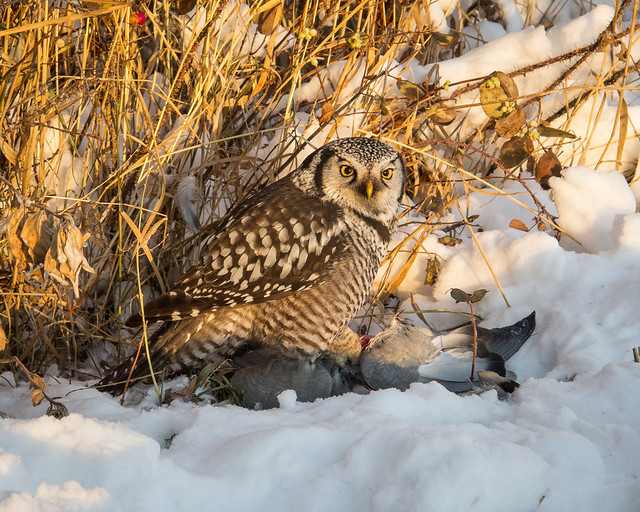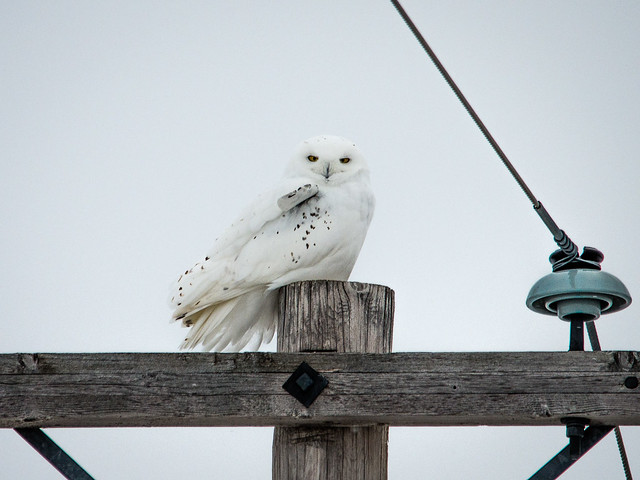Boreal Owl
As their name indicates, Boreal Owl live year-round in the spruce and fir forests of northern Canada. They are small birds (8-11 in) with a square-shaped head. They have white spots on a brown back and brown streaks on a white belly. The grayish white facial disc is surrounded by a dark border and there are tiny white spots on the top of their head.
Boreal Owl hunt at night, sitting on a tree branch until they spot and pounce on their prey (small rodents and squirrels).
They lay up to 19 eggs in tree cavities, such as those created by woodpeckers. They will also make use of nest boxes when they are provided.
Did you know? The male’s low hooting call can be heard from mid-February to April as they entice the females with food and song. The males offer the females a choice of 1-5 nesting sites on their territory and feed them for up to 3 months prior to nesting.
Burrowing Owl
Burrowing Owl are tiny (7.5-10 in) with long legs and a short tail. They are a mottled brown with white eyebrows and throat. They can be found during the summer in southwestern Canada and the western United States. Northern birds migrate further south for the winter. They are found year-round in southern California, New Mexico, Arizona, Texas, and the Florida Panhandle.
Burrowing Owl live in treeless areas with an open view and plenty of holes for shelter. Look for them standing on the ground next to their burrow or perched on a nearby fence post. You may see them near a prairie dog colony as the owls use the abandoned burrows of prairie dogs and ground squirrels for nests.
Burrowing Owl turn their head upside down when curious and bob up and down when threatened. They are active day and night.
Could it be? Long-eared Owl, Short-eared Owl, and Snowy Owl also live in grassland areas, but they're all much larger than the Burrowing Owl. Short-eared Owl (14-17 in) are the most similar, but they have shorter legs, an obvious facial disc, and fly low over the fields rather than walking on the ground.
Did you know? Burrowing Owl often line the entrance to their burrows with animal dung to attract insects that they then catch and eat.
Great Gray Owl
Great Gray Owl are the tallest (24-33 in) North American owl with the largest wingspan (4.5-5 ft) but are mostly fluff and only half the weight of a Snowy Owl or a Great Horned Owl. They can be found year-round in the evergreen forests of Alaska and northern Canada as well as the western mountain region stretching from British Columbia through Washington, Idaho, Montana, and parts of California. They have silvery gray feathers, a round head with a large facial disc, a black and white bowtie across the neck, and yellow eyes and beak.
Great Gray Owl hunt for rodents and other small mammals during the day. They prefer a mix of dense forest for nesting and open areas (meadows, clearings) for hunting.
Could it be? Great Horned Owl hunt at night and have earlike tufts on their head. Northern Hawk Owl are also found in northern boreal forests, but they have a long tail and short pointed wings. Barred Owl are smaller with dark eyes and no black-and-white throat markings.
Did you know? Great Gray Owl live in Scandinavia, Russia, Siberia, and Mongolia as well as North America.
Great Horned Owl
Great Horned Owl can be found in forests from the Arctic all the way to South America where their short, wide wings allow them to manoeuvre between the trees. They are large (18-25 in) birds with long earlike tufts pointing out to the side, a white bib, a dark brown body with white markings, and bright yellow eyes. They have a deep hooting voice that is unlike any other North American owl.
Could it be? Great Gray Owl are also forest dwellers, but they hunt during the day and don't have ear tufts. Long-eared Owl prefer open grasslands and are smaller and slender with ear tufts that point straight up rather than out at a slight angle.
Did you know? Great Horned Owl are ferocious predators with prey ranging from birds or mammals larger than themselves to small insects, mice, and frogs. They use their large, strong talons to break the spine of large prey.
Long-eared Owl
Long-eared Owl are slender birds (13-16 in) with long ear tufts pointing straight up. Their dark mottled feathers and rusty-orange facial disc provide excellent camouflage when roosting during the day in thick stands of trees. They can be found in Canada during the summer breeding season and are found year-round and during the winter in the United States. They may be spotted in the far southern interior of British Columbia all year round.
Long-eared Owl hunt in open grasslands at night, occasionally at dusk, flying low over the ground and searching for prey by sight or sound. They eat small mammals, particularly rodents.
Long-eared Owl don't build their own nests. Instead, they use stick nests built by crow and magpie.
Could it be? Great Horned Owl are larger than Long-eared Owl. Their ear tufts are shorter and point out at an angle rather than straight up and down.
Did you know? If disturbed on their nest, Long-eared Owl raise their ear tufts and compress their feathers to disguise themselves as a broken branch.
Northern Hawk Owl
As their name indicates, Northern Hawk Owl bear similarities to hawks as well as owls. They are the only owl with a long hawk-like tail, but their head and body are wider than a hawk’s. They have a dark, medium-sized (14-17 in) body with white markings and a pale face surrounded by a black border.
Northern Hawk Owl hunt during the day, pouncing on their prey from on high like a hawk. They can be found year-round in the boreal forests of Alaska and northern Canada. They move south in extreme weather or when there is a shortage of food.
Did you know? Northern Hawk Owl can detect prey by sight at up to half a mile.
Northern Saw-whet Owl
Northern Saw-whet Owl are small birds (7-8.5 in), close to the size of a Robin. They have a large round head, big yellow eyes surrounded by a white facial disc, and no ear tufts. They have a brown back and a white breast with dark brown streaks. They hunt at night for rodents, especially mice. Listen for their single shrill repeating call.
Northern Saw-whet Owl are forest dwellers and can be found year-round in southern Canada, southern Alaska, as well as forested regions from Washington to California, from Montana to Arizona and New Mexico, and around the Great Lakes and the northeastern United States. They winter in the dense forests of central and southern United States.
Could it be? Northern Saw-whet Owl are smaller than Boreal Owl with streaks instead of spots on their forehead. Screech Owl are also small, but they have ear tufts.
Did you know? Young Northern Saw-whet Owl are very distinctive as they have a dark brown head, a white triangle on their forehead, and a rusty-colored breast.
Short-eared Owl
Short-eared Owl can be found in open grasslands from North and South America to Europe and Asia. In Canada, you will be most likely to spot them in the spring as they migrate north to breed, although some breed in Saskatchewan.
Short-eared Owl are medium-sized owls (13-17 in). Their yellow eyes are rimmed in black within a pale facial disk. They have streaky brown feathers with broad, rounded wings. The small ear tufts can be hard to spot. A pale patch on their upper wings can be spotted when they are in flight.
Short-eared Owl are most active at dawn or dusk. They fly low over open areas, ready to pounce on voles and other rodents and occasionally birds (especially in coastal areas).
They are unusual among owls as they construct their own nest, a hollow in the ground lined with grass and feathers. Males bring food to the females who then feed the young.
Did you know? Female Short-eared Owls are reluctant to leave the nest when they are breeding. If they have to, they defecate on the eggs, presumably hoping that the stink will deter predators and mask the smell of the nest.
Snowy Owl
Snowy Owl prefer treeless, wide-open spaces. The islands high above the Arctic Circle are their summer breeding grounds, but they can be seen in Saskatchewan during the winter flying over the fields or perched on a fence post or hay bale as they scan the area for small animal prey. Some years large numbers will appear south of the Canadian border in search of food.
Snowy Owl (20-28 in, 50-57 in wingspan) have a round head and yellow eyes in a white facial disc. Males can be pure white, but females have mixed white and brown feathers. Their feet are covered with feathers to protect them from the cold.
Did you know? Snowy Owl hunt both day and night, perhaps because they've adapted to almost day-long sunlight during the Arctic summer and day-long darkness in the winter.
See also: Five Amazing Facts about Owls
Find out more about Saskatchewan wildlife on EcoFriendly Sask’s Nature Companion, a free nature app covering Canada's four western provinces.




